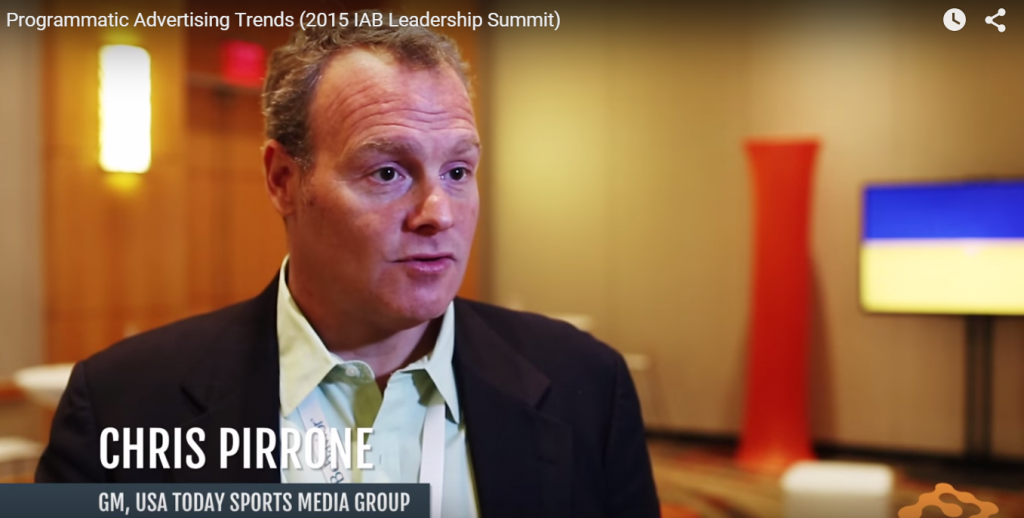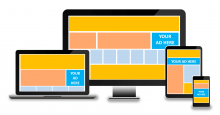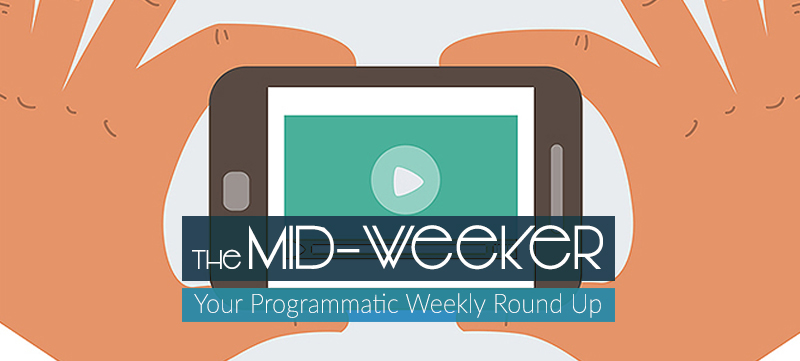Programmatic Advertising Trends from the IAB 2015 Leadership Summit

A number of industry leaders discuss the trends in programmatic advertising at the IAB Leadership Summit. Key challenges discussed include the limited inventory available for video and the use of data to individualise campaigns.
Full Screen Interactive Ads Shown to be Most Memorable for Brands
 With digital display ad spend set to rise by 21.8% this year, advertisers are looking out for how to best optimise their campaigns. Now, new research by Undertone has come out that proclaims full-screen interactive ads as the best option to boost brand recall. This is true regardless of whether the ad is viewed on smartphone or tablet. The study results showed that 45% of tablet users and 44% of smartphone users recalled the full-screen interactive ad. In contrast, standard ads were recalled by only 35% of tablet users and only 23% of mobile users. IAB Rising Star ad formats did not fare much better, with 27% recall on tablets and 25% recall on smartphones. Undertone theorise that this is due to the fact that the unexpanded IAB Rising Star format looks similar to standard display formats and did not force users to interact. Read more.
With digital display ad spend set to rise by 21.8% this year, advertisers are looking out for how to best optimise their campaigns. Now, new research by Undertone has come out that proclaims full-screen interactive ads as the best option to boost brand recall. This is true regardless of whether the ad is viewed on smartphone or tablet. The study results showed that 45% of tablet users and 44% of smartphone users recalled the full-screen interactive ad. In contrast, standard ads were recalled by only 35% of tablet users and only 23% of mobile users. IAB Rising Star ad formats did not fare much better, with 27% recall on tablets and 25% recall on smartphones. Undertone theorise that this is due to the fact that the unexpanded IAB Rising Star format looks similar to standard display formats and did not force users to interact. Read more.
Time Inc. Adds Audience Categories As ‘Programmatic Print’ Takes Off

12 new audience categories have been added to Time Inc.’s programmatic print offering. This means that there are now 18 audience segments that media planners can buy from, including sport enthusiasts, fashion followers, and foodies. Time Inc. was surprised with how quickly programmatic print has gained popularity, with over a million dollars of inventory already sold. Time Inc. now expects this figure to reach several million by the end of the year. In order for programmatic print to be a reality, the use of data is essential. Surveys were conducted to gain insights into the readership of the magazines, so that when an audience is bought, the advertisement is placed across relevant magazines. One thing to note is that programmatic print is not entirely automated, since salespeople are a vital part of getting advertisers on board. Read more.
New York Times to Remove All Mobile Interstitials and Banners by End of Q3
 The New York Times is planning to get rid of full page interstitials and banners in a bold new move towards native advertising. The new ‘Mobile Moments’ ad solution will replace the current advertising on the mobile version of the site. ‘Mobile Moments’ takes into consideration a user’s day-to-day activities in order to serve highly relevant branded content. After a year of research, seven key moments of a reader’s day have been identified by the Times. The Times hope that by applying this consumer insight, advertisers will be able to serve more effective ads, which will be less disruptive for the end user. By introducing these native ads, the Times is hoping to increase the $182.2 million it made on digital advertising last year. Read more.
The New York Times is planning to get rid of full page interstitials and banners in a bold new move towards native advertising. The new ‘Mobile Moments’ ad solution will replace the current advertising on the mobile version of the site. ‘Mobile Moments’ takes into consideration a user’s day-to-day activities in order to serve highly relevant branded content. After a year of research, seven key moments of a reader’s day have been identified by the Times. The Times hope that by applying this consumer insight, advertisers will be able to serve more effective ads, which will be less disruptive for the end user. By introducing these native ads, the Times is hoping to increase the $182.2 million it made on digital advertising last year. Read more.
Tablet Usage to Grow 11% in Western Europe this Year
 New research from eMarketer has predicted that 163.3 million people across Western Europe will use tablets in 2015, which works out as 39.1% of the total population. The UK will have the highest number of tablet users, 32.8 million. By 2019 this is set to increase to 40.2 million. Germany and France come in second and third place respectively with 31 million and 24.4 million users. In the UK, around two-thirds of those with access to the internet will also be tablet users. The forecast shows that the popularity of tablet devices will continue to climb, especially in the northern regions of Western Europe. In fact, tablet usage is set to grow by 40 million in only 4 years with the report predicting that 48.4% of the population of Western Europe will be tablet users by 2019. This should come as no surprise to advertisers who have seen the popularity and importance of mobile and tablets continue to grow and exceed desktop in recent years. Read more.
New research from eMarketer has predicted that 163.3 million people across Western Europe will use tablets in 2015, which works out as 39.1% of the total population. The UK will have the highest number of tablet users, 32.8 million. By 2019 this is set to increase to 40.2 million. Germany and France come in second and third place respectively with 31 million and 24.4 million users. In the UK, around two-thirds of those with access to the internet will also be tablet users. The forecast shows that the popularity of tablet devices will continue to climb, especially in the northern regions of Western Europe. In fact, tablet usage is set to grow by 40 million in only 4 years with the report predicting that 48.4% of the population of Western Europe will be tablet users by 2019. This should come as no surprise to advertisers who have seen the popularity and importance of mobile and tablets continue to grow and exceed desktop in recent years. Read more.
Insights on Programmatic Video from Q2 2015 (Infographic)
 Tremor Video, Inc. has created an infographic, using the findings from new research, about the changing landscape of the online video marketplace. While the largest increase in video consumption has been on smartphones (36%), consumers watching on larger screens are 3.6 times more likely to watch the ad until the end. Unsurprisingly, shorter videos are more likely to be watched all the way through, with video completion dropping by 33% when videos are 60 seconds rather than 30. Throughout the day, smartphone usage is consistent, whereas desktop usage peeks during work hours. For marketers that use video in their campaigns, the infographic contains a selection of interesting statistics that are worth taking a look at. Read more.
Tremor Video, Inc. has created an infographic, using the findings from new research, about the changing landscape of the online video marketplace. While the largest increase in video consumption has been on smartphones (36%), consumers watching on larger screens are 3.6 times more likely to watch the ad until the end. Unsurprisingly, shorter videos are more likely to be watched all the way through, with video completion dropping by 33% when videos are 60 seconds rather than 30. Throughout the day, smartphone usage is consistent, whereas desktop usage peeks during work hours. For marketers that use video in their campaigns, the infographic contains a selection of interesting statistics that are worth taking a look at. Read more.
In the Age of Programmatic, Clickbait Loses its Appeal
 When advertisers were most interested in view-count, journalists were forced to write stories that would entice people to click. With traditional CPM pricing models, the publisher had little incentive to keep the audience’s attention after they had clicked onto the page, and hence counted as an impression. But with the increasing importance of programmatic buying, the sheer volume of impressions does not necessarily lead to higher revenues, since the cost of the impression varies on the basis of its quality. Audience value is set to become an important measurement in programmatic; when this becomes standardised, clickbait will become an even more ineffective tactic for publishers and advertisers alike. Read more.
When advertisers were most interested in view-count, journalists were forced to write stories that would entice people to click. With traditional CPM pricing models, the publisher had little incentive to keep the audience’s attention after they had clicked onto the page, and hence counted as an impression. But with the increasing importance of programmatic buying, the sheer volume of impressions does not necessarily lead to higher revenues, since the cost of the impression varies on the basis of its quality. Audience value is set to become an important measurement in programmatic; when this becomes standardised, clickbait will become an even more ineffective tactic for publishers and advertisers alike. Read more.
Subscribe to our mailing list to get the latest Programmatic news directly to your inbox


